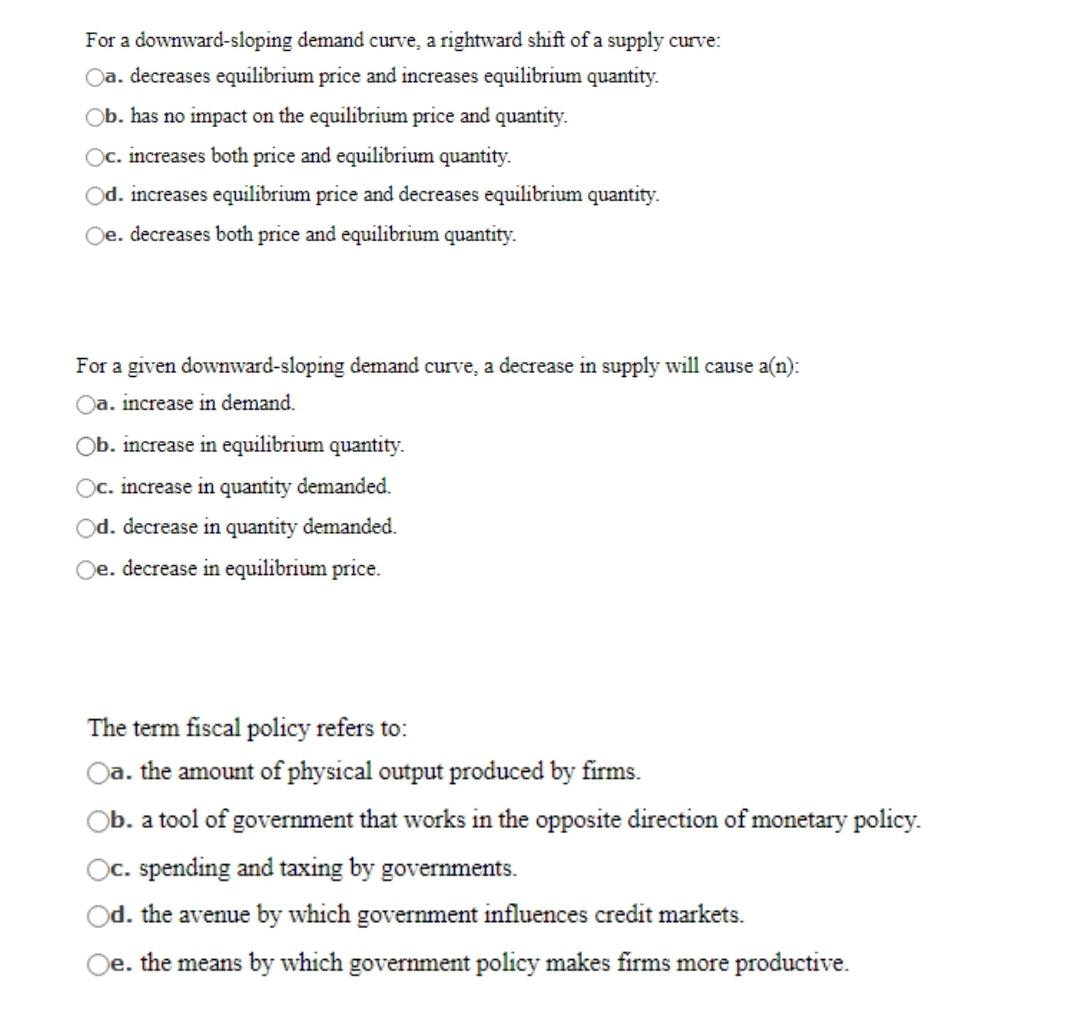For a downward-sloping demand curve, a rightward shift of a supply curve: Oa. decreases equilibrium price and increases equilibrium quantity. Ob. has no impact on the equilibrium price and quantity. Oc. increases both price and equilibrium quantity. Od. increases equilibrium price and decreases equilibrium quantity. Oe. decreases both price and equilibrium quantity.
For a downward-sloping demand curve, a rightward shift of a supply curve: Oa. decreases equilibrium price and increases equilibrium quantity. Ob. has no impact on the equilibrium price and quantity. Oc. increases both price and equilibrium quantity. Od. increases equilibrium price and decreases equilibrium quantity. Oe. decreases both price and equilibrium quantity.
Chapter4: Supply And Demand: An Initial Look
Section: Chapter Questions
Problem 5TY
Related questions
Question

Transcribed Image Text:For a downward-sloping demand curve, a rightward shift of a supply curve:
Oa. decreases equilibrium price and increases equilibrium quantity.
Ob. has no impact on the equilibrium price and quantity.
Oc. increases both price and equilibrium quantity.
Od. increases equilibrium price and decreases equilibrium quantity.
Oe. decreases both price and equilibrium quantity.
For a given downward-sloping demand curve, a decrease in supply will cause a(n):
Oa. increase in demand.
Ob. increase in equilibrium quantity.
Oc. increase in quantity demanded.
Od. decrease in quantity demanded.
Oe. decrease in equilibrium price.
The term fiscal policy refers to:
Oa. the amount of physical output produced by firms.
Ob. a tool of government that works in the opposite direction of monetary policy.
Oc. spending and taxing by governments.
Od. the avenue by which government influences credit markets.
Oe. the means by which government policy makes firms more productive.
Expert Solution
This question has been solved!
Explore an expertly crafted, step-by-step solution for a thorough understanding of key concepts.
Step by step
Solved in 2 steps

Knowledge Booster
Learn more about
Need a deep-dive on the concept behind this application? Look no further. Learn more about this topic, economics and related others by exploring similar questions and additional content below.Recommended textbooks for you


Microeconomics: Principles & Policy
Economics
ISBN:
9781337794992
Author:
William J. Baumol, Alan S. Blinder, John L. Solow
Publisher:
Cengage Learning

Managerial Economics: A Problem Solving Approach
Economics
ISBN:
9781337106665
Author:
Luke M. Froeb, Brian T. McCann, Michael R. Ward, Mike Shor
Publisher:
Cengage Learning


Microeconomics: Principles & Policy
Economics
ISBN:
9781337794992
Author:
William J. Baumol, Alan S. Blinder, John L. Solow
Publisher:
Cengage Learning

Managerial Economics: A Problem Solving Approach
Economics
ISBN:
9781337106665
Author:
Luke M. Froeb, Brian T. McCann, Michael R. Ward, Mike Shor
Publisher:
Cengage Learning


